
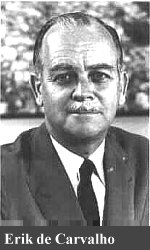
On 22 June, 1960 landed in Galeão
airport VARIG’s first flight from New York with Boeing 707-441,
equiped with four Rolls-Royce engines, which guaranteed fuel economy
and more range over other versions. With B707, VARIG was the first
airline to offer nonstop flights between Rio de Janeiro and New
York.
In August, 1961 VARIG purchased Real-Aerovias-Nacional airlines,
which was in financial difficulties. Thus VARIG become
Brazil’s domestic market leader and expanded its international network
to Lima, Bogota, Caracas, Mexico, Miami and Los Angeles. After
purchase Real-Aerovias-Nacional, VARIG's domestic network
grown to more than 90 cities
in Brazil and
the fleet reached almost 100 aircraft.
Shortly later, VARIG became also the leader in international market,
when has inherited Panair do Brasil’s routes to Europe. To assume
such new routes, VARIG acquired Boeing 707-300 and Douglas DC-8-33.
In very little time VARIG started flights to Lisbon, Madrid, Rome,
Paris, Zurich, Frankfurt, London and Beirut, consolidating itself as the largest airline in Latin America.
VARIG was the
only airline in the world to operate the three first-generation
American jets: Boeing 707, Convair 990 and Douglas DC-8
simultaneously.
However, in December 1966, Ruben Berta dies at his office desk. In
his place assumed Erik Kastrup de Carvalho, who previously worked at
Panair. Erik continued VARIG's international expansion, that arrived on the
other side of the world, in 1968, when launched flights to
Tokyo. For
domestic market, VARIG brought the fast and silent Lockheed Electra
II. They replaced Convair 240 and Caravelle on main domestic
routes, including Rio de Janeiro - São Paulo "Ponte Aérea" (Air
Bridge).
Another
measure was the fleet standardization, which won several aircraft
models after the acquisition of Real-Aerovias-Nacional consortium.
By the end of the decade, Douglas DC-6, Convair 240/340/440 and
Lockheed Super H Constellation were withdrawn, as well as about half
of Douglas DC-3 fleet. In the meantime, VARIG was obliged to receive
aircraft it did not want, but were previously ordered by Real, such
as Convair 990 and Lockheed Electra II.
At the end of
the decade, VARIG also selected the DC-3 successor, the HS-748, also
known as "Avro". A unit was operated experimentally between 1965 and
1966. VARIG also analyzed other options such as Beechcraft 99, FH-227
and Fokker 27. The first HS-748 entered into commercial operation in
1968, replacing DC-3 in regional routes, mainly in Rio Grande do Sul
state.


Arrival of the first Boeing 707 (PP-VJA) and on-board service in
B707's 1st Class (Museu VARIG)
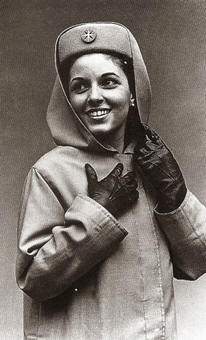


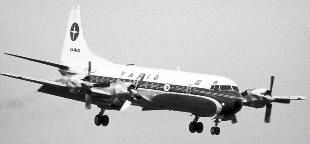
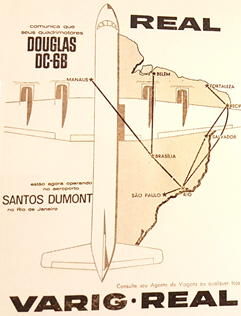
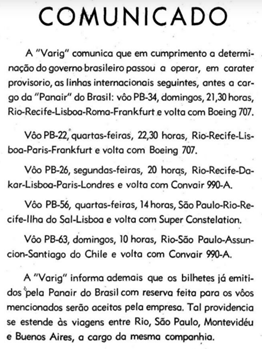
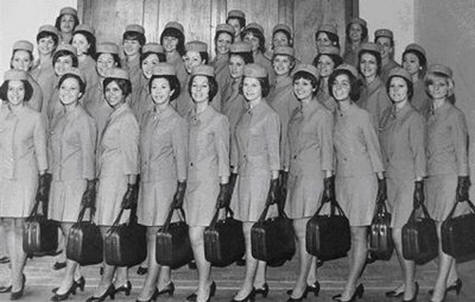

VARIG's crew - 60s / Lockheed Electra II
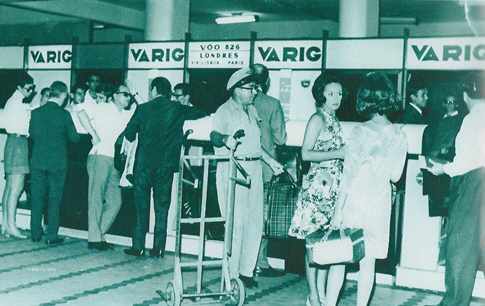
VARIG's boarding in Galeão International Airport, Rio de
Janeiro - 60s (Museu VARIG)
 |
|
HOW WAS FLYING IN THE 1960s?
Were
aviation's "golden age", flying was very chic and very
expensive. The slogan: “VARIG, a forma elegante de voar”
(VARIG, the stylish way of fly).
Even though it was summer, passengers were wearing their
best suits and dresses, including gloves and hat. On
board reception was served French champagne or scotch
for all passengers, including those in economy class.
Smiling and elegant cabin crew with uniforms designed by
famous designer, light cigarette for passengers. Wide
seats and located at least one meter from the other in
front. The big attraction was the meal: in First Class:
caviar and shrimp cascades. In Economy Class two choice
of hot food, entrance, cheese, dessert and drinks. In
First Class, passenger enjoyed a true five star
restaurant, with hot towels for hygiene, table towel,
linen napkins, silverware and crystal glasses.
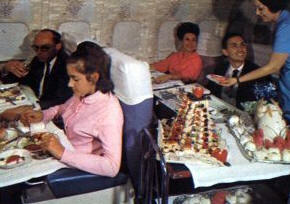

If the glamor continued as ever,
travel time changed a lot in the 1960s. With the
introduction of jets, travel time was reduced to less
than half. The most glamorous line of VARIG, Rio de
Janeiro - New York, formerly made with Super G
Constellation and lasted about 25 hours, was reduced to
only 9 hours with Boeing 707. And the best, the flight
was non-stop. This gave VARIG a big advantage over its
rival Pan Am. VARIG's Boeing 707-440 were equipped with
more powerful engines, capable of making the route
non-stop. While Pan Am's Boeing 707-320 were equipped
with Pratt & Whitney engines and needed to make a
stopover, making the flight take longer. In addition to
time advantage, VARIG offered unrivaled on-board service
and an extremely comfortable internal configuration,
with 48 First Class seats, 60 Economy Class seats, a
sitting room, six bathrooms and a wash room.
However operate the longest route in
commercial aviation so far was not easy. VARIG's Boeing
707s operated at full capacity, with full fuel tanks (sacrificing
load capacity) and needed to use full length of Galeão's
runway, the longest runway in Brazil. Even so, Boeing
707 still could not gain enough altitude to stay above
Santos Dummont airport traffic and the traffic of this
airport was interrupted during departures of VARIG's
flight to New York.
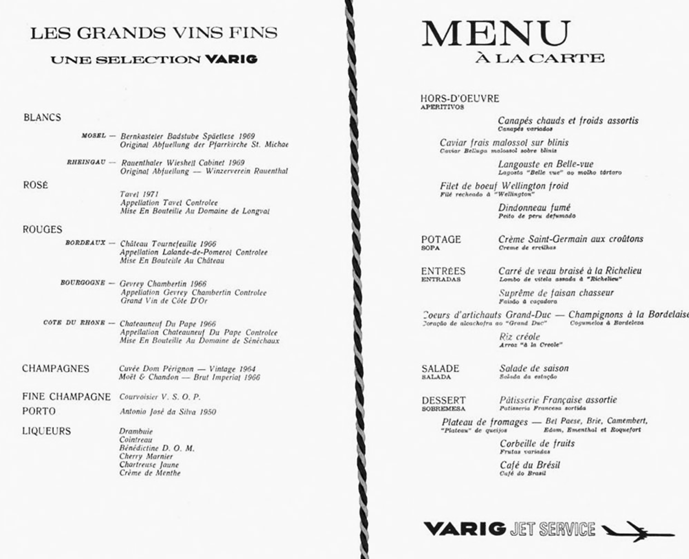
VARIG's menu in 60s
|
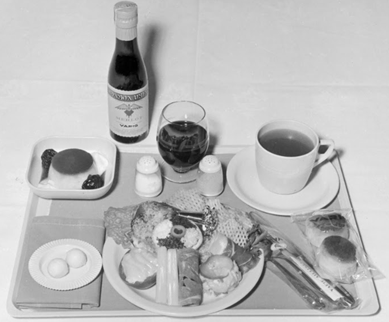


Economy Class meal / Boeing 707 /
Onboard service - Boeing 707
|
60s |
Fleet:
03xBoeing
707-300
02xBoeing 707-400
02xCaravelle I
12xConvair 240/340/440
02xConvair 990A
21xCurtiss C-46
38xDouglas DC-3
03xDouglas DC-6
01xDouglas DC-8-33
02xHS-748 "Avro"
04xLockheed L1049G Constellation
05xLockheed L188 Electra II
TOTAL: 95 |
|
President:
Erik
Kastrup de Carvalho
Domestic Destinations:
94 cities
International Destinations:
Montevideo, Buenos Aires, Santiago,
Asuncion, Lima, Bogota, Caracas, Panamá, Mexico
City,
Santo Domingo, Miami, Los Angeles, New York, Sal
Island, Monrovia, Lisbon, Madrid, Paris, Roma,
Milan, Zurich, Frankfurt, London, Beirut,
Copenhagen, Tokyo
Passengers Transported:
1.34 million in
1969
|
|
Fleet
evolution:

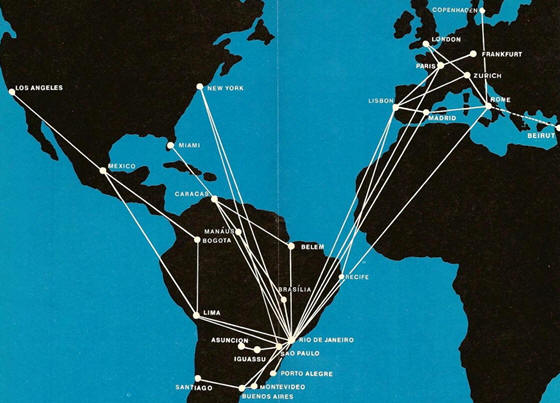
VARIG's international route map in 1968

 |
|
FOCUS: Varig and the route to New York
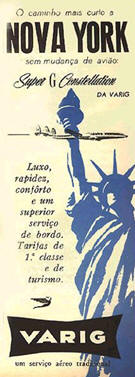 VARIG's
first international long-haul route was to New York, in
July 1955. Ever since this was VARIG's most important
route until the end of the flights in 2006. The first
aircraft used on the route was Super G Constellation,
which along with Douglas DC-7 was the most advanced
four-engine at that time. But unlike DC-7, Super
Constellation was also famous for its beauty and became
the biggest icon of aviation's glamor in the 50s. Build
to carry over one hundred passengers, VARIG had an ultra
comfortable setting with just about 60 seats. The flight
time was 25 hours and with stops in Belém and Trujillo.
Initially the flight was twice a week and by the end of
50s VARIG doubled the frequencies. VARIG's
first international long-haul route was to New York, in
July 1955. Ever since this was VARIG's most important
route until the end of the flights in 2006. The first
aircraft used on the route was Super G Constellation,
which along with Douglas DC-7 was the most advanced
four-engine at that time. But unlike DC-7, Super
Constellation was also famous for its beauty and became
the biggest icon of aviation's glamor in the 50s. Build
to carry over one hundred passengers, VARIG had an ultra
comfortable setting with just about 60 seats. The flight
time was 25 hours and with stops in Belém and Trujillo.
Initially the flight was twice a week and by the end of
50s VARIG doubled the frequencies.
Also in 50s VARIG received more Super G Constellation,
but this time equipped with "wing tip tank", so now it
could fly from Rio de Janeiro to New York with only one
stop. Thereafter VARIG offered flights between Rio and
New York with two stops (in Bethlehem and Truijillo) and
one stop (in Port of Spain).
Despite the improvement achieved with the wing tip tank,
VARIG knew that it needed to do more. After all VARIG
was competing with nothing less than Pan Am. So VARIG
ordered the modern Boeing 707 and Caravelle jets in
1957. But Caravelle arrived before. Caravelle was a jet
designed to operate only on short routes, anyway VARIG
immediately used Caravelle in its route to New York,
becoming the first airline in the world to operate a jet
at JFK in 1959. As Caravelle had no autonomy to make
nonstop flight to New York, it made stops in Belém, Port
of Spain and Nassau. Nevertheless Caravelle reduced
flight time from 25 to 14 hours. After that VARIG
operated Rio - New York route twice a week with
Caravelle and twice a week with Super G Constellation.
In 1960 the Boeing 707-441 finally arrived, the main
weapon against the powerful Pan Am. VARIG had chose and
waited for the 400 version just because it was the only
one capable to fly nonstop between Rio de Janeiro and
New York, thanks to the new Rolls Royce engines. Pan Am
operated the Boeing 707-320 with Pratt & Witney, who had
not sufficient autonomy and needed to make a stop. It
gave a great advantage to VARIG, since it was the only
one to offer nonstop flights between Rio and New York.
However to achieve that VARIG operated at maximum limits,
requiring full power of the engines and almost all the
runway length. With the introduction of Boeing 707-441,
the flight time was reduced to just nine hours. The
Boeing 707-441 could carry about 150 passengers, but
VARIG's used a more comfortable setting with fewer seats,
six bathrooms and a washstand.
In 1960 VARIG offered three flights per week nonstop
with Boeing 707-441, two flights per week with Caravelle
with stops in Belém, Port of Spain and Nassau and two
flights per week with Super G Constellation with stops
in Port of Spain or in Belém and Trujillo.
In 1961 Caravelle stopped operating on the route to New
York and VARIG's frequencies were: two weekly nonstop
with Boeing 707-441, one with stops in Brasilia and Port
of Spain with Boeing 707-441 and two weekly with Super G
Constellation.
In 1966 arrived the first Boeing 707-341C with new Pratt
& Witney JT3D engines able to fly farther than Boeing
707-441. Therefore Boeing 707-320C replaced both Super G
Constellation and Boeng 707-441 on Rio de Janeiro - New
York route, now only nonstop.
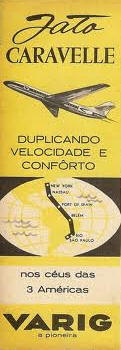 Everything
was going well when, in 1970, Boeing and Pan Am
introduce the new Boeing 747-100 wide-body. From that
moment DC-8 and Boeing 707 outdated. With two aisles and
much more capacity of previous jets, the new generation
intercontinental jets changed forever the commercial
aviation. VARIG knew it was a matter of time for Pan Am
bring a wide-body to Brazil's route. So VARIG ordered
the new Douglas DC-10-30 wide-body. On July 1, 1974
VARIG operated the first flight to New York with a
wide-body aircraft. Initially VARIG's DC-10 were
configured with 30 seats in first class and 211 in
economy class, a total of 241 seats. Years later VARIG
introduced the business class. Everything
was going well when, in 1970, Boeing and Pan Am
introduce the new Boeing 747-100 wide-body. From that
moment DC-8 and Boeing 707 outdated. With two aisles and
much more capacity of previous jets, the new generation
intercontinental jets changed forever the commercial
aviation. VARIG knew it was a matter of time for Pan Am
bring a wide-body to Brazil's route. So VARIG ordered
the new Douglas DC-10-30 wide-body. On July 1, 1974
VARIG operated the first flight to New York with a
wide-body aircraft. Initially VARIG's DC-10 were
configured with 30 seats in first class and 211 in
economy class, a total of 241 seats. Years later VARIG
introduced the business class.
Although DC-10 was a wide-body, it wasn't as successful
as the Boeing 747 and it was not too hard to figure out
why. The fact was that Boeing 747 was the largest
commercial aircraft in history, but Brazilian demand was
not large enough for an aircraft with than 300 seats.
Only in February 1981 VARIG acquired its first Boeing
747. The advantage was that the Boeing 747 was a Combi
verion, ie half passenger half cargo and instead of more
than 300 seats, only about 250. On February 12, 1981
VARIG's Boeing 747-200B made the first flight on Rio
de Janeiro - New York route. Now, besides have the same
aircraft of Pan Am, VARIG had a more modern version
(Boeing 747-200 against Boeing 747-100 used by Pan Am).
At the end of the 80s VARIG introduced an even larger
and modern aircraft, the Boeing 747-300. Initially in
Combi version, but in 1988 VARIG received the first
Boeing 747-300 "full passenger", able to carry about 400
passengers.
In 1987 VARIG received it first new generation jet, the
Boeing 767-200ER, that began to share with Boeing 747
and Douglas DC-10 the route to New York.
Another important milestone in Brazilian aviation was in
1989, when VARIG inaugurated Guarulhos International
Airport. Guess what was the route? New York - São Paulo
with B747. After that the main VARIG's flight to New
York was from São Paulo instead of Rio de Janeiro.
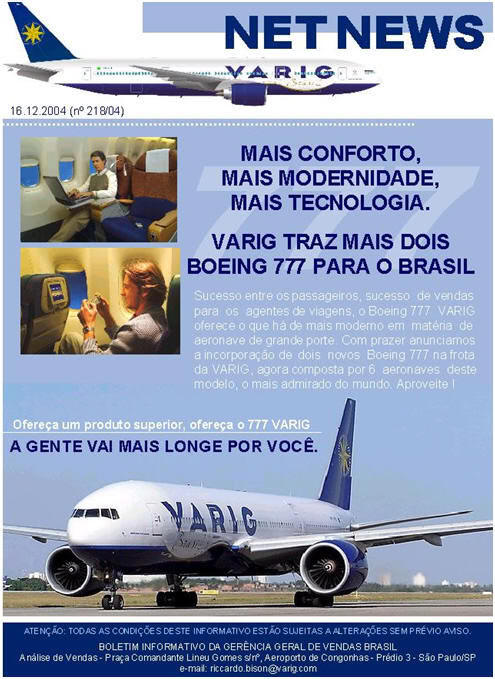 In
early 90s Boeing 747 and Douglas DC-10 were replaced by
the new MD-11, the most advanced aircraft in 1990 with
full computerized cockpit and digital systems. However
USA - Brazil market changed radically in the 90s,
divided only by VARIG and Pan Am. In 1992 Pan Am went
bankrupt and was replaced by American Airlines and and
join the market also Transbrasil, Vasp, United,
Continental and Delta. As a result the tickets prices
and load factor slumped. In
early 90s Boeing 747 and Douglas DC-10 were replaced by
the new MD-11, the most advanced aircraft in 1990 with
full computerized cockpit and digital systems. However
USA - Brazil market changed radically in the 90s,
divided only by VARIG and Pan Am. In 1992 Pan Am went
bankrupt and was replaced by American Airlines and and
join the market also Transbrasil, Vasp, United,
Continental and Delta. As a result the tickets prices
and load factor slumped.
In 1998 Tam started flying to Miami with its
ultra-modern Airbus A330 equipped with individual
entertainment in all classes and armchairs that recline
180 degrees in business class. The old VARIG's MD-11 was
not able to compete.
In November 2001 VARIG received it first Boeing 777-200,
the most modern aircraft of that time. Finally the
airline had an aircraft able to compete with the other
airlines. However the first Boeing 777 began operate
flights to Europe, only later replaced the MD-11 on São
Paulo - New York route.
In November 2005 Tam made its first flight to New York
with the A330. In June 2006 VARIG indefinitely canceled
its flights to New York, but the company never returned
flights to its first intercontinental destination. |






























 VARIG's
first international long-haul route was to New York, in
July 1955. Ever since this was VARIG's most important
route until the end of the flights in 2006. The first
aircraft used on the route was Super G Constellation,
which along with Douglas DC-7 was the most advanced
four-engine at that time. But unlike DC-7, Super
Constellation was also famous for its beauty and became
the biggest icon of aviation's glamor in the 50s. Build
to carry over one hundred passengers, VARIG had an ultra
comfortable setting with just about 60 seats. The flight
time was 25 hours and with stops in Belém and Trujillo.
Initially the flight was twice a week and by the end of
50s VARIG doubled the frequencies.
VARIG's
first international long-haul route was to New York, in
July 1955. Ever since this was VARIG's most important
route until the end of the flights in 2006. The first
aircraft used on the route was Super G Constellation,
which along with Douglas DC-7 was the most advanced
four-engine at that time. But unlike DC-7, Super
Constellation was also famous for its beauty and became
the biggest icon of aviation's glamor in the 50s. Build
to carry over one hundred passengers, VARIG had an ultra
comfortable setting with just about 60 seats. The flight
time was 25 hours and with stops in Belém and Trujillo.
Initially the flight was twice a week and by the end of
50s VARIG doubled the frequencies. Everything
was going well when, in 1970, Boeing and Pan Am
introduce the new Boeing 747-100 wide-body. From that
moment DC-8 and Boeing 707 outdated. With two aisles and
much more capacity of previous jets, the new generation
intercontinental jets changed forever the commercial
aviation. VARIG knew it was a matter of time for Pan Am
bring a wide-body to Brazil's route. So VARIG ordered
the new Douglas DC-10-30 wide-body. On July 1, 1974
VARIG operated the first flight to New York with a
wide-body aircraft. Initially VARIG's DC-10 were
configured with 30 seats in first class and 211 in
economy class, a total of 241 seats. Years later VARIG
introduced the business class.
Everything
was going well when, in 1970, Boeing and Pan Am
introduce the new Boeing 747-100 wide-body. From that
moment DC-8 and Boeing 707 outdated. With two aisles and
much more capacity of previous jets, the new generation
intercontinental jets changed forever the commercial
aviation. VARIG knew it was a matter of time for Pan Am
bring a wide-body to Brazil's route. So VARIG ordered
the new Douglas DC-10-30 wide-body. On July 1, 1974
VARIG operated the first flight to New York with a
wide-body aircraft. Initially VARIG's DC-10 were
configured with 30 seats in first class and 211 in
economy class, a total of 241 seats. Years later VARIG
introduced the business class. In
early 90s Boeing 747 and Douglas DC-10 were replaced by
the new MD-11, the most advanced aircraft in 1990 with
full computerized cockpit and digital systems. However
USA - Brazil market changed radically in the 90s,
divided only by VARIG and Pan Am. In 1992 Pan Am went
bankrupt and was replaced by American Airlines and and
join the market also Transbrasil, Vasp, United,
Continental and Delta. As a result the tickets prices
and load factor slumped.
In
early 90s Boeing 747 and Douglas DC-10 were replaced by
the new MD-11, the most advanced aircraft in 1990 with
full computerized cockpit and digital systems. However
USA - Brazil market changed radically in the 90s,
divided only by VARIG and Pan Am. In 1992 Pan Am went
bankrupt and was replaced by American Airlines and and
join the market also Transbrasil, Vasp, United,
Continental and Delta. As a result the tickets prices
and load factor slumped.